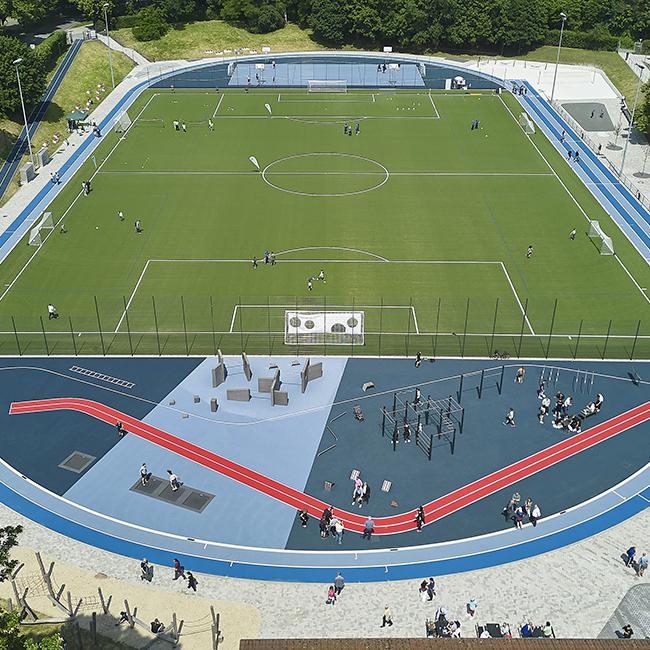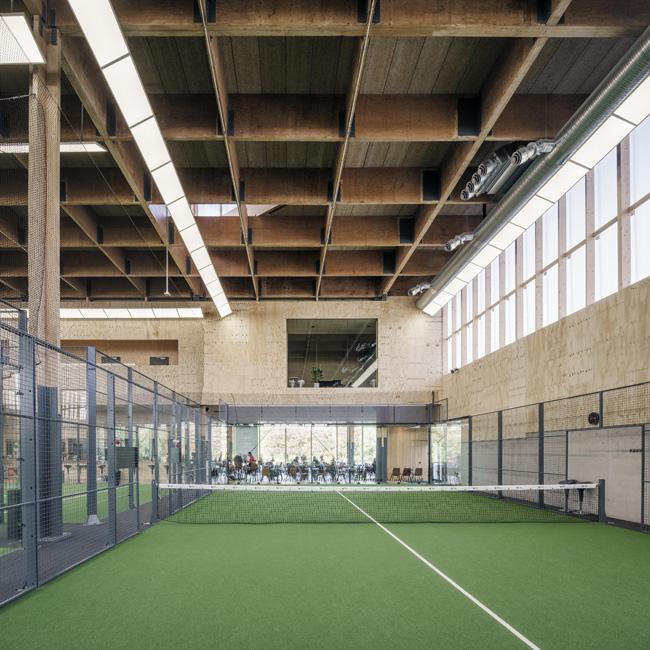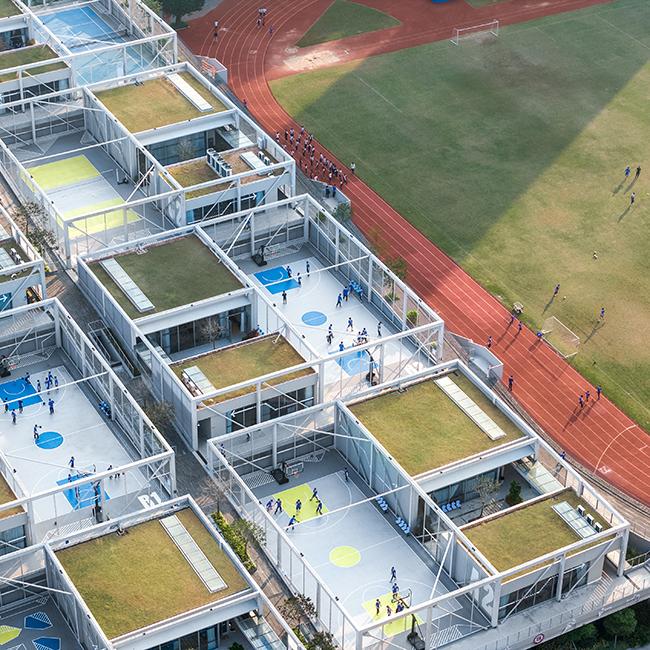published in sb 2/2020
Current and future challenges for stadium operators
The single driving question is “What makes a stadium successful?” To answer this is as complex as the question is deceptively simple: It depends.
Although the principles for achieving success are universal, the answer clearly depends on whether the facility is old, existing, or new or in the process of being designed.
The majority of stadiums in Europe are existing facilities, and some date back to the 1980’s. Even the most recent generation of stadia, with a few exceptions, were conceived over a decade ago. The design of these stadiums happened in an era when the top of the agenda was occupied by safety and security, and the priority was to put on the event a few times per year and walk away, safely.
Of course, we all know that sustainability and eco-programmes have taken over the top of the agenda, especially with the realisation that climate change is a world-wide phenomenon.

o2 Arena © Julian Anderson

Author
John Barrow, Director,
ESSMA Services, and previously
Senior Principal, Populous
In fact, sustainability started to become recognised by stadium designers in the mid-1990’s, evidenced by some of the features which appeared on the Olympic Stadium in Sydney in 2000. The introduction of massive rainwater tanks for pitch irrigation, photo-voltaics, convective cooling and natural lighting, joined the list of grey water use, low carbon footprint, minimal embodied energy in the building materials, low maintenance regimes and waste management.
What wasn’t so obvious at that time, was the concentration on legacy planning. The concept that stadiums must be flexible for alternative uses, including other sports, entertainment and community uses, business conferences, offices and even residential accommodation, is at the heart of every new stadium design going forward. It is important to understand the complex rationale which has led to this universal mantra, which is partly driven by the desire to make these facilities more available throughout the year, and partly to drive additional revenue generation.
Here is the true definition of sustainability: Much-needed environmental improvements of course, community legacy benefits naturally, but also business revenue to create the three-legged model that is needed for a long term sustainable solution. In a nutshell, that is what we are now seeing in the latest designs such as Tottenham’s new stadium. However, the philosophy holds true for smaller stadiums too, even with smaller budgets and simpler business models.
Need your own copy? Or even better: subscribe to the sb magazine - and you receive all six issues per year
The aim of every club or stadium partner must be to progressively introduce features which enhance safety and security, to simplify operations, at the same time to incorporate all of the environmental standards required to achieve carbon neutral status by 2050, and to embrace technology to maximise the fans’ experience.
The challenge is to generate enough revenue to achieve financial viability over the lifetime of the stadium, typically 30-50 years. Even older stadiums can be renovated to meet this challenge, and in some cases, an unforeseen benefit of a sensitively renovated stadium can be the retention of the past historical references cherished by
the fans.
Of course, the individual approach is dependent on the circumstances of each stadium. Many stadiums are owned by the local or regional authority, and therefore the actual operation of the stadium may fall outside the club’s influence as a tenant. However, it is in everyone’s interests to maximise the asset, to increase usage and revenue, and to minimise ongoing costs.

o2 Arena © Julian Anderson
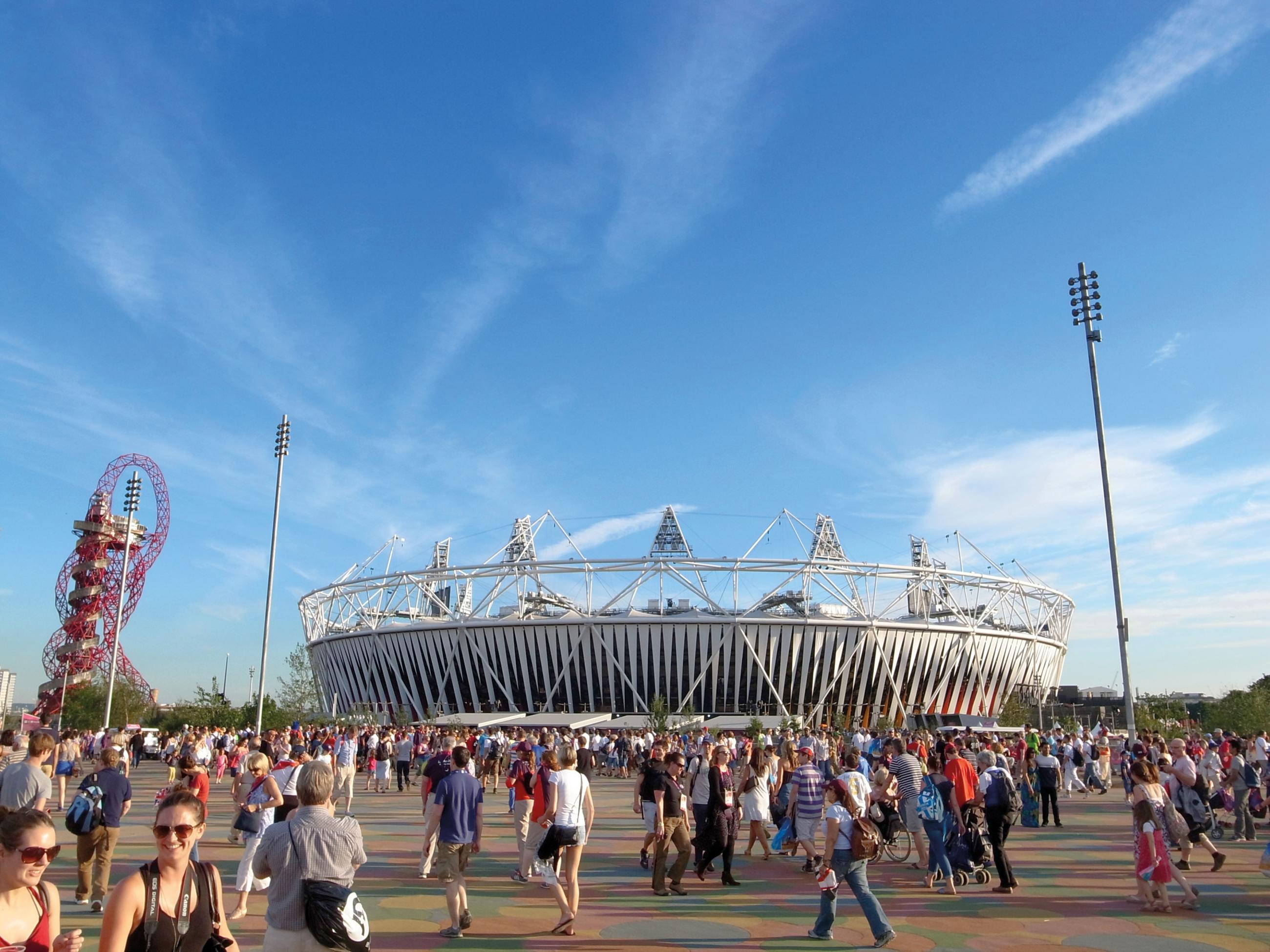
London Olympic Stadium © Simon Borg
Fundamentally, a stadium must not be considered as a stand-alone sports facility, but as a living, breathing public amenity which can pay its own way in conjunction with surrounding development, and which is open 360 days per year, at least in part.
Where does sustainability come in all of this? When the three-legged definition of a realistic sustainability programme is considered, environment, business and community legacy, each stage of a stadium development and operation can be carefully evaluated to ensure that there is a suitable balance to ensure long-term viability.
Drilling down into some detail, let’s look at some of the things that should be included in any agenda for a stadium operator:
Market study
Stadium operators need to know their target audience at any point in time, and therefore a regular updated market survey of the fans, corporate guests, naming rights partners, broadcasting partners and the players, will be required to set the scene for long-term analysis of trends in the future. For example, the suite provision in many stadiums is being reduced to make way for more networking lounges, and stadiums with built-in flexibility make this type of conversion simple.
Financial appraisal
The business plan will need to look at the whole-life scenario rather than a short-term view if the stadium operator is to achieve best value from the facility. The business plan must form part of the sustainability report.
Sustainability Report
Climate change is now a compelling factor in any stadium development, and the effects of climate change must be taken into account in the management and operation of any stadium, new or old.
The latest court decision in the UK against the expansion of Heathrow Airport may have a major implication for any infrastructure project, including stadia and arenas, all of which will have to satisfy the government target of elimination of carbon emissions by 2050. It is likely that this agenda will be adopted by the EU in general in the near future. To meet this target will require in-depth studies to demonstrate how the venue intends to comply in realistic terms with this policy.
The latest court decision in the UK against the expansion of Heathrow Airport may have a major implication for any infrastructure project, including stadia and arenas, all of which will have to satisfy the government target of elimination of carbon emissions by 2050. It is likely that this agenda will be adopted by the EU in general in the near future. To meet this target will require in-depth studies to demonstrate how the venue intends to comply in realistic terms with this policy.
Bearing in mind that major projects can take a decade or more to realise, there will be much more pressure on stadium operators and their design teams to apply imaginative solutions to every aspect of the stadium, in order to reduce the carbon footprint and the carbon emissions. There is an immense challenge for existing stadiums to adapt their existing infrastructure and operations to meet the strict requirements, and in some ways, this will be a more difficult task for older venues.
So it is clear that every stadium operator and club must take the future seriously, and to put in place a sustainability roadmap now.
Screening
The UK Government is considering new security laws related to public assembly buildings, in the wake of the Manchester Arena bombing. Martyn’s Law, named after one of the victims, will require venue operators to provide multi-layered security, including mag and bag screening and extended secure perimeter zones, to all stadiums and arenas. The O2 Arena in London has been used as an example of how this might work, having had mag and bag procedures in operation for over ten years. Under the strict new laws, no hand luggage or carry bags will be allowed into the venue. At the London O2, up to eight million visitors each year are screened progressively from the transport interchange, external piazza, outer building perimeter, and the inner secure perimeter.
The recent coronavirus epidemic has seen the need for rapid body temperature checks at airports, and this will be brought in to stadium entry procedures as well.
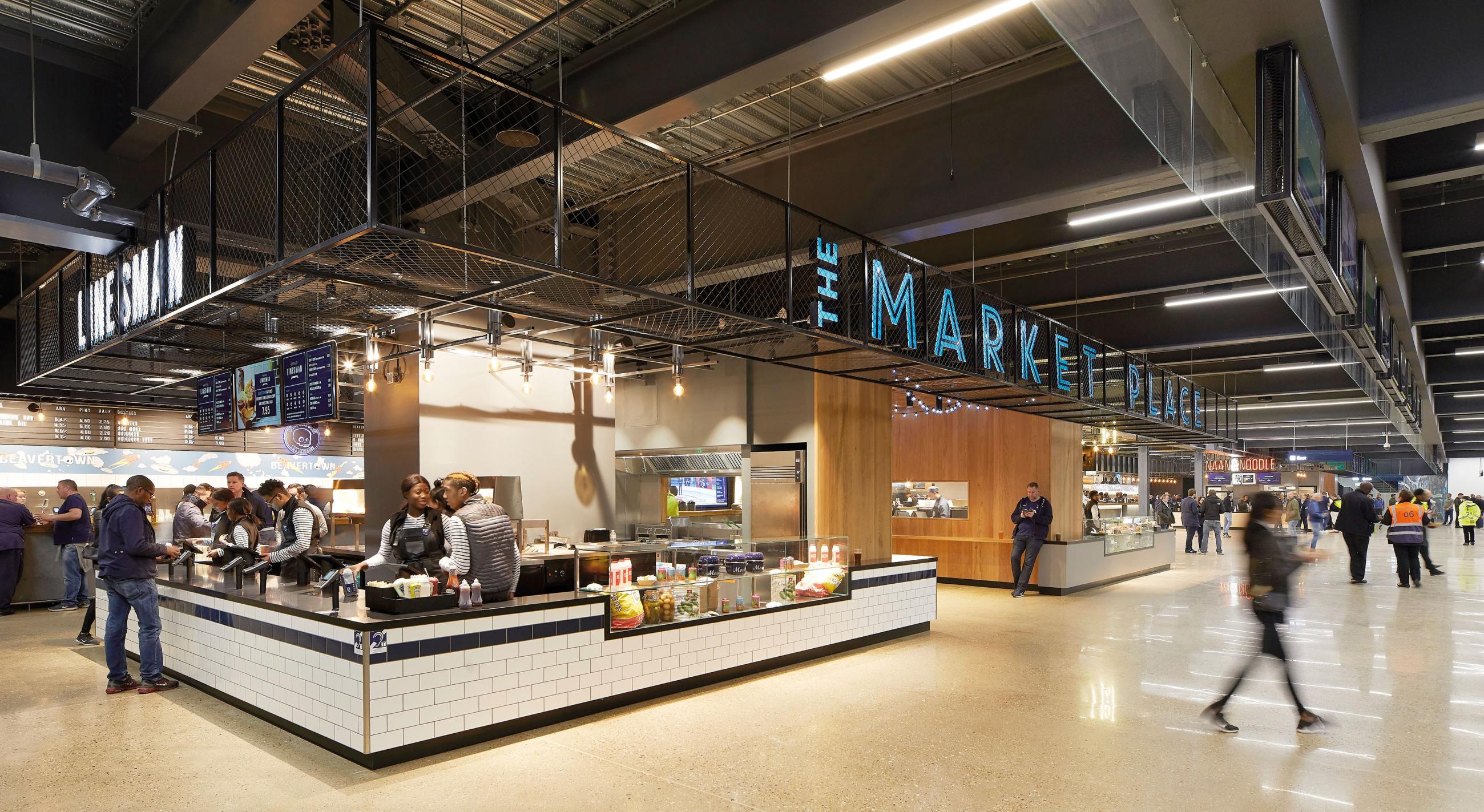
Tottenham Hotspur Stadium © Hufton&Crow
Queueing zones
Inevitably, enhanced security measures will introduce some delay, and therefore it is important for the stadium operator to provide information screens at the security checkpoints to communicate with visitors, and to give clear updates and even entertainment while they are queueing. The entrance procession is an integral part of the visitors’ experience, so this should be as efficient and enjoyable as possible. Excellent way-finding signage is an important part of this experience.
Increasing dwell-time for fans pre- and post-event
Encouraging fans to arrive early at the stadium, and leave well after the event, is a well-established concept that helps to minimise crowding, increase fan entertainment and to increase revenue generation. Fan-zones were introduced for major events such as the World Cup, where non-ticketholders could enjoy live video broadcasts on mega-screens. Many clubs have taken this idea to provide a special experience for their fans, with access to the club store, hall of fame, and stadium tours including roof walks.

Tottenham Hotspur Stadium © Tottenham Hotspur
The updated UK guidelines recommend a two-hour target pre- and post-event period for visitors to enjoy fan-zones within the outer security perimeter, where food and beverages, merchandise, entertainment and meeting places will be made available. These visitors will benefit from already passing through the initial security and health checks, so the path to their seats will be shorter and more enjoyable. Post-event concerts are now a common feature, and these may be introduced on non-matchdays as well. Increased stewarding and security costs will have to be taken into account of course.
Recycling of water and waste
Recycling waste and reduction of plastic is a major concern, and the laws concerning waste recycling and treatment will be progressively tightened. Removing plastic altogether from the food and beverages on offer, will be a great step forward. On-site separation and compacting of recycling waste is an essential feature of most recycling programs today, and innovative processes exist for recycling plastic into merchandising. Arsenal uses a waste management scheme, which involves an anaerobic digestion chamber to turn food waste into energy.
Pitch management
Event certainty is a term used for a variety of challenges related to putting on the event. The centre of most events is the field of play, and its condition is critical to the success of the event. Therefore, many stadium operators have opted for a hybrid synthetic/natural grass solution with under-pitch heating and drainage, pitch ventilation and solar lighting arrays, to ensure the best performance. Problems may arise when other events are held on the same surface, particularly concerts, or even motorsport events, and consequently the pitch may take some time to recover.
Rugby requires a longer grass height, for example, and therefore the event program must be carefully forecast to ensure sufficient down-time between these events for pitch recovery.
American Football is generally played on a full synthetic surface, (although there are some exceptions such as Phoenix), and uniquely, Tottenham have installed two overlapping pitches, one hybrid for football and one synthetic for American Football, to ensure the perfect conditions for each sport.
In the future, robotically-operated removable modular pitches grown in hydroponics towers may be the answer to some stadium operators’ need to replace their pitch up to five or six times per year. This very expensive routine is currently the case in a number of European multi-event stadiums.
Alternative energy sources
Typically, every stadium operator will be obliged to follow the example of Wembley Stadium, which is powered by 100 % renewable energy and it is a zero waste-to-landfill stadium.
In addition, the potential for photovoltaic arrays exists on large structures like the Lusail Stadium in Qatar, but maintenance and cleaning requirements must be taken into account where rooftop locations are proposed. Locations are usually selected on carparks or training facilities.
Similarly, wind turbines tend to be more efficient as independent structures away from buildings, located in parkland for example, but the high cost of single mast turbines has been a problem to date. Post-Olympics, at the Queen Elizabeth Olympic Park in London, a series of seven smaller 18 metre vertical-axis wind turbines has been installed successfully.
At a simple level, the use of natural lighting is limited in stadium designs, but in some cases, running costs can be dramatically reduced on non-event days in particular, using reflective adjustable solar shafts in concourses and back-of-house areas.
LED lighting has a much lower running temperature, lower energy consumption, longer life and improved colour rendering than halogen lighting, and the trend for conversion is accelerating in most stadiums. Larger and larger screens are now the norm, both inside the stadium and outside on the façades. In the future, the façades of stadiums will be covered in LED systems to provide naming rights platforms, announcements, and live feedback.
WIFI and 5G
Stadiums are a natural choice for 5G installations, as face recognition, contactless purchasing, fast track pre-ordering and live feedback are all facilitated by this technology.
Smaller stadiums operators struggle to afford WIFI systems throughout the facility, but this is now becoming an essential requirement for most clubs.
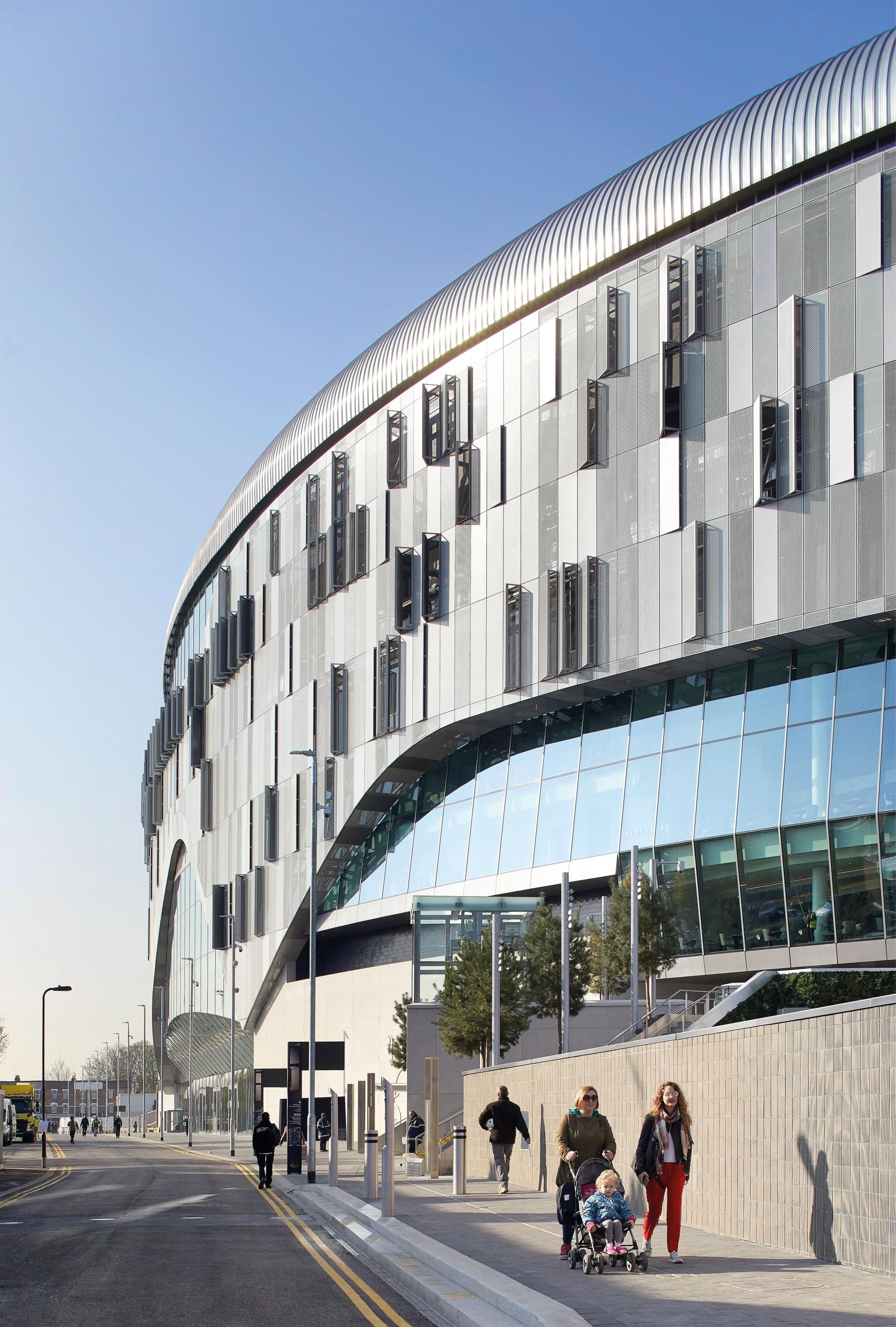
Tottenham Hotspur Stadium © Hufton&Crow
Public transport and reduction of private carparking
European stadium operators are often surprised by the minimal carparking provision in UK stadiums. For example, Arsenal Emirates stadium has just 550 spaces, and even Wembley only has 2,000. The UK government policy of minimising private transport modes contrasts dramatically with some other countries, where thousands of carparking spaces are provided due to the unavailability of public transport. The problem is two-fold: carparks are expensive to build, and tend to occupy valuable real estate. Secondly, the larger the carpark, the longer it will take to exit, sometimes adding up to two hours to damage an otherwise good experience.
The solution is usually dependent on government funding, so that, where possible, a tram, bus, metro or train interchange should be less than one kilometre from the stadium, servicing the needs of the majority of spectators, especially families and disabled people. Greater provision of cycle paths and storage is becoming a simple but effective way to allow people to use an eco-friendly mode of transport from nearby communities.
Away supporters’ experience
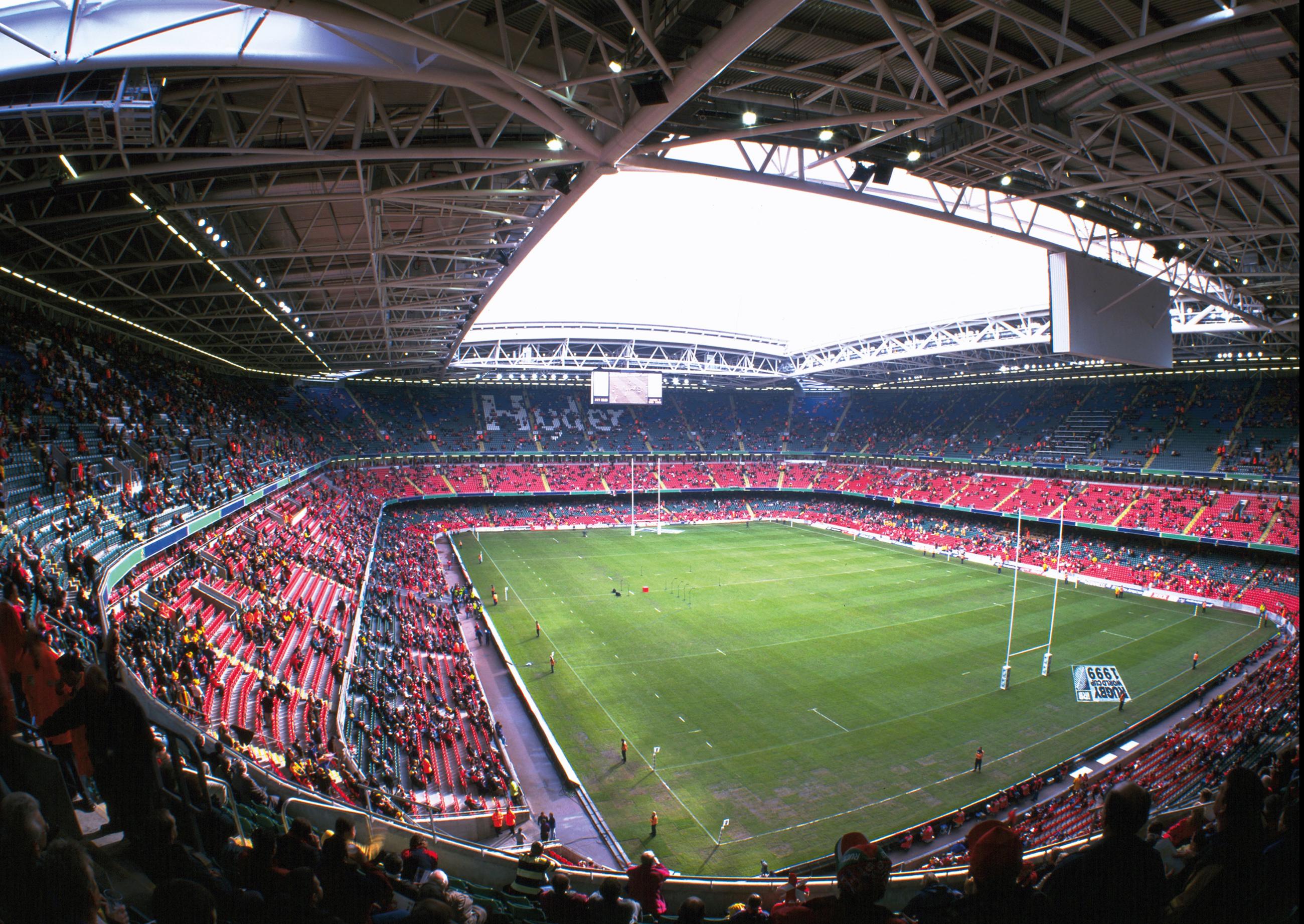
Millennium StadiumPatrick BinghamHall © Patrick Bingham Hall
Many European stadiums provide a minimal experience for away supporters, with the intention of discouraging their enthusiasm. Studies are underway to use reverse psychology in surprising away supporters by giving them the same quality of experience as the home supporters. Controversial as it may seem, the objectives are to reduce instances of hooliganism, vandalism and graffiti. The use of glass crowd barriers, like at Juventus, and providing good food and beverage kiosks in inviting spaces, can lead to a better atmosphere all round.
Wall of sound
As Liverpool, Dortmund and now Tottenham have shown, the effect of a single tier mega-stand behind the goal is an amazing feature to assist the home team advantage!
Modern stadium design includes the capture of sound within a facility to increase the atmosphere, even more so when there is a retractable roof like Cardiff.
Stewarding
The role of a stadium steward these days cannot be under-estimated. Trained in emergency procedures, resuscitation, crowd management, meet and greet, self-defence and communications, most stewards work on a voluntary basis, with a few rewards each year.
The selection and training of the stewards is a vital part of any stadium operation, and their involvement can impact on people’s experience in a positive way.
Players’ and officials experience
A common theme is: If the players are enjoying themselves, then everyone will enjoy the event. The ripple effect from centre-stage, whether it is a football match or a concert, is measurable in the audience’s appreciation.
TV and media facilities, club TV, fan podcasts, photo-booths
Communication with the audience is a key to success in any venue. Most clubs have some form of digital and social media department, allowing interaction between players, management, local community and fans to happen at all levels. The facilities within a stadium, such as the fan zones, interview rooms, mixed zone, press and media lounges all give an impression of the club’s commitment.
Ancillary development opportunities including hotels, arenas, retail and residential, health clubs and pools
The big success factor can often be found in the integration of surrounding development, or in the case of Arsenal, a combination of redevelopment of the old Highbury stadium, together with residential and commercial development to the south and east of the stadium.
At Wembley, the development of the surrounding precinct is still on-going, over a decade after the new stadium opened. The combination of hotels, offices, indoor arena and leisure is slowly dealing with the perennial challenge of activating the areas around a large stadium during non-event days.
Even more acutely, the completion of a similar story for Olympique Lyonnais is approaching: In the case of OL Park, located well outside the city centre, it is vital that a new community hub is established around the stadium, in order to create the destination effect which will encourage fans and general public to use the facilities on non-match days. Here, the mix of a regional retail centre, club store, hall of fame, hotels, indoor arena, health and leisure, and outdoor concourse events will activate the whole area, in conjunction with the OL Training Center right next door, where community programmes including training and jogging are available.
Training facilities like the OL Training Center are ideally placed in the same location as the stadium, not simply for ease of management, but also for the halo effect that the proximity of the stadium can give to young aspiring players.
Conclusion
One thing that I have learnt through 40 years of experience in sports architecture is never to be complacent. The lessons are still there to be learnt. Every day requirements change, and every day, technology and knowledge rise to the challenges.
Where do we go to look for this knowledge? IAKS and ESSMA both offer programmes designed to assist the industry to improve the quality of stadiums.
About ESSMA
At ESSMA (European Stadium & Safety Management Association) we’re working closely with over 350 European clubs and stadiums on the further development of our industry. Although every stadium and case are different and should be approached in this way as well, the main challenges of today are global and common.
First of all, expanding the stay of fans inside the stadium is a key challenge. Not only from a commercial point of view (having people longer inside the stadium will make them spend more), but also to decrease the waiting lines at entry points and concession stands. And of course, stadium design plays a major role in this. We see that when stadiums offer a convenient space with entertainment, people come earlier. In the old White Hart Lane, Tottenham Hotspur FC had the worst score in terms of fan arrivals, in the new stadium they are topping the list.
Secondly, the importance of experiences cannot be underestimated. Giving people a qualitative offer, both towards hospitality guests and general public. Apart from the quality, the range of offers seems to increase as well. An interesting evolution is that the price range is expanding as well, as the cheapest ticket options became cheaper and the premium products became even more expensive. This all helps to provide a more segmented and personalised offer.
Lastly, with the terror threat, the priority of safety and security is understandable. Definitely if we take a look at research on people who never attended stadium events before. Their primary reason not to attend is the fear of violence and risks. It is our mission to seduce these people by organising safety and security below the surface and provide them with a fantastic guest experience.
Overall, technology will be a major component to deal with these challenges. When designing a new venue, it is difficult to predict which technology will be available and used, so it comes down to provide sufficient flexibility and adapt as latest as possible in the project. 5G is definitely something we are following closely, as it will bring a totally new approach to stadiums. In NFL, 13 out of the 32 have now access to 5G and are discovering the new possibilities, this year VfL Wolfsburg did a first test in light of the EURO 2024 Championship.

Cyril De Greve
Managing Director
ESSMA
In our experience, these factors all have to be taken into account when answering the question what makes a stadium successful.
www.essma.eu


